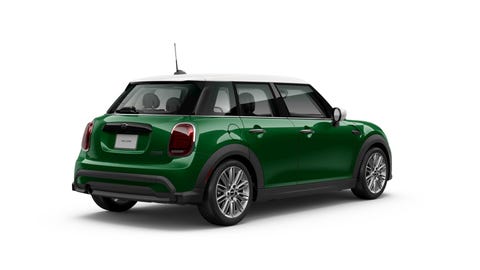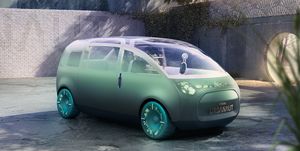Minis may have a reputation for being BMW-priced, but the reality is nowhere as daunting. Just as the average cost of a new car eclipses the $40,000 mark, getting into a Mini—even one optioned with some popular features—can cost about half that: the Mini Oxford Edition is priced at $20,600 for the 2022 two-door model, and $21,600 for the four-door.
More surprising is that this pricing is unchanged since 2018.
The Oxford Editions include an 8.8-inch touchscreen media display, leatherette upholstery, a digital instrument cluster, LED headlights, Union Jack taillights, front-collision- and lane-departure-warning systems, and 12 months of Sirius/XM Satellite Radio. All of these items are standard equipment on the Mini Hardtop Classic trim, but the Oxford Edition bundles them at a special price. The Oxford Edition tops it all off with 17-inch silver or black wheels, heated front seats, dual-zone automatic climate control, and an Anthracite-colored headliner. The models are offered in a choice of six exterior colors, and a choice of white or black contrast mirror caps and roof.
Mini points out that the 2022 Oxford Editions feature an additional $3,000 in standard equipment, but offer an MSRP that’s $3,150 lower, amounting to a total value of $6,150.
“Our specially equipped Mini Oxford Editions are attractively priced to offer potential customers a new Mini that is more attainable than ever before,” said Product Planning Manager Ishaan Khatri of Mini USA. “In addition to their value, these new 2022 Oxford Edition hardtops offer all the goodness of Mini’s stylish and fun to drive character.”
The Oxford Plus package can also add a seven-speed dual-clutch automatic transmission and a panoramic moonroof for an additional $1,500—items that would otherwise be priced $2,500 separately on other models as options.
The Oxford Edition, of course, is based on the updated Mini Cooper range, which was facelifted just in January of this year. The Mini received a larger grille, restyled front bumpers, a new version of Mini iDrive with an 8.8-inch screen, and a revised steering wheel design, among other small updates. The previous facelift took place in 2018, while the current UKL-platform Mini Cooper range itself dates back to early 2014.
A complete redesign is still some distance over the horizon as Mini maneuvers itself to offer more electric models and perhaps resurrect some classic names like the Traveller, which is expected to be a small MPV.
Should Mini keep gas-engined models past 2030, or should it aim to offer more EVs as soon as possible? Let us know in the comments below.
Source: Read Full Article




